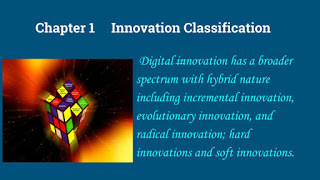The New Book “Unpuzzling Innovation” Introduction: Chapter 1 Innovation Classification
 For many, innovation is serendipity; from others, it is a buzz word. It has many definitions. There is a vast terminology (types of innovation) in what some researchers call incremental (improvement, continuous, modular, components, etc.) and others call radical (breakthrough, disruptive, system, paradigmatic) innovation. For a business, innovation is “anything that is new to you.” The innovation classification is based on the position of the concept in the evolution tree. The classification is not based on the required investment, or on the potential market, but on its evolution abilities.
For many, innovation is serendipity; from others, it is a buzz word. It has many definitions. There is a vast terminology (types of innovation) in what some researchers call incremental (improvement, continuous, modular, components, etc.) and others call radical (breakthrough, disruptive, system, paradigmatic) innovation. For a business, innovation is “anything that is new to you.” The innovation classification is based on the position of the concept in the evolution tree. The classification is not based on the required investment, or on the potential market, but on its evolution abilities.Breakthrough innovation: Breakthrough innovation is better with greater ROI but with much greater risk. You need new technology, new processes, new customers, or even a new business model. All that makes them very risky, but on the other hand, you will get very great chances and opportunities for new product lines, platforms., etc. Research identifies the projects that ultimately break new ground frequently are fraught with uncertainty on many dimensions: technical, market, resource and organizational uncertainties abound. This requires them to be managed with fine-tuned processes to deal with uncertainty, but not stomp it out immediately. Breakthrough innovation is a radical new approach that leaves competitions behind in some way, it is disruptive and will change your organization in many fields.
Incremental Innovation: Innovation is in the eye of the beholder -customer. The only test for whether it is or is not an innovation is whether it makes any difference to a dimension that is valued by whoever has a stake in your offering. An incremental improvement of a product that allows the company increase sales, revenue, profit margins, market share, etc, is innovation. Adding value is the characteristics of an innovation. You cannot “disrupt” without incremental innovation being part of the process. Incremental innovation has become the value that the customer expects you to provide if you are to remain a sustainable supporting innovation, the unexpected disruption that can re-structure the competitive landscape.
 Business Model innovation: A business model is a multi-level, zoomable schema of how a business or an organization creates, delivers, and captures value for stakeholders: Customers, businesses, investors, or society. A business model is “why this business works.” If you can’t answer that in a few words, you probably don’t have a viable business. The business model defines customers, needs and solutions as well as competitive advantage. Ideally, a business balances its activities and resources in such a way, that it can be successful at both creating new forms of value and delivering and capturing from its existing forms. The starting point of business model innovation reflects one’s state of mind, so when you begin to design the model, you have to, as a business leader be very clear what you are and how you want to approach the markets. The mindset, vision, competency, capability, culture, and marketing opportunity are all great starting point for business model innovation.
Business Model innovation: A business model is a multi-level, zoomable schema of how a business or an organization creates, delivers, and captures value for stakeholders: Customers, businesses, investors, or society. A business model is “why this business works.” If you can’t answer that in a few words, you probably don’t have a viable business. The business model defines customers, needs and solutions as well as competitive advantage. Ideally, a business balances its activities and resources in such a way, that it can be successful at both creating new forms of value and delivering and capturing from its existing forms. The starting point of business model innovation reflects one’s state of mind, so when you begin to design the model, you have to, as a business leader be very clear what you are and how you want to approach the markets. The mindset, vision, competency, capability, culture, and marketing opportunity are all great starting point for business model innovation.Innovation comes in many flavors and there are many opportunities in an enterprise to do so. Incremental innovation is quantitative progress and radical innovation is transformational leapfrog. A healthy innovation portfolio needs to have both in order to reach innovation horizon with the optimal speed at the right time.Follow us at: @Pearl_Zhu
Published on November 23, 2016 23:11
No comments have been added yet.



